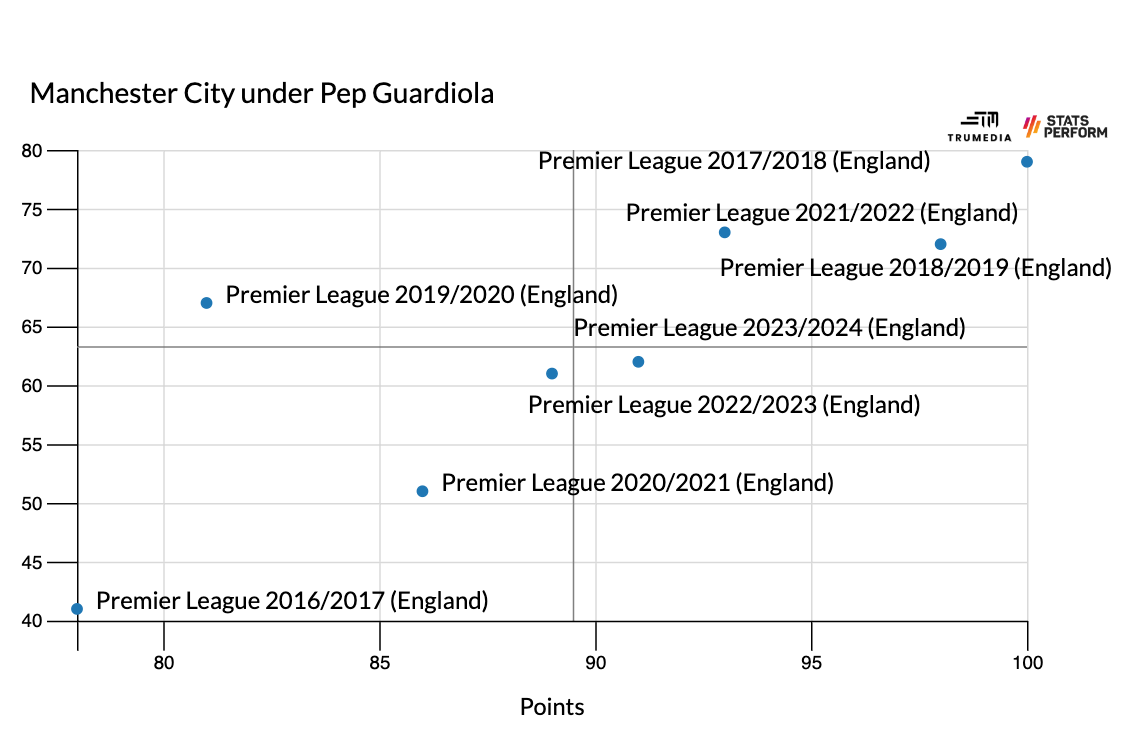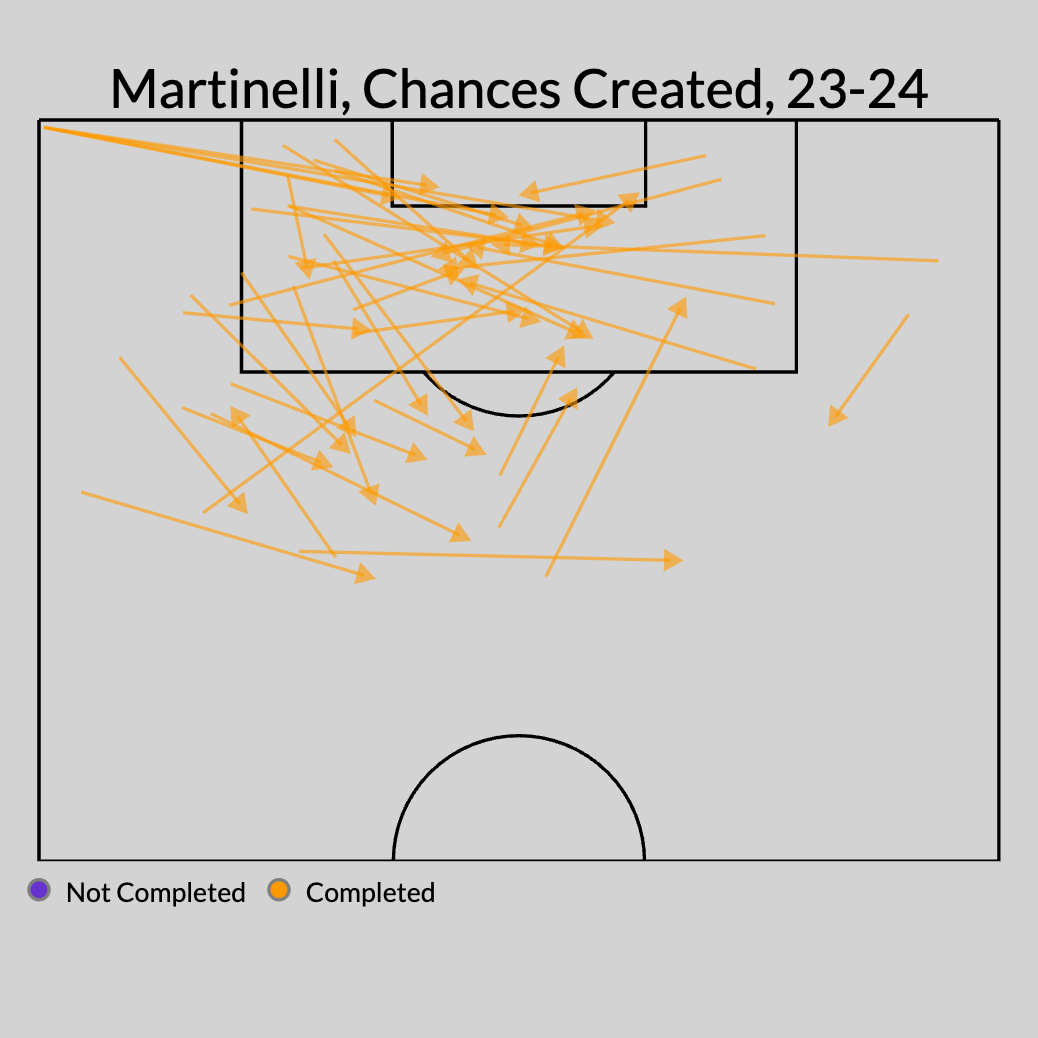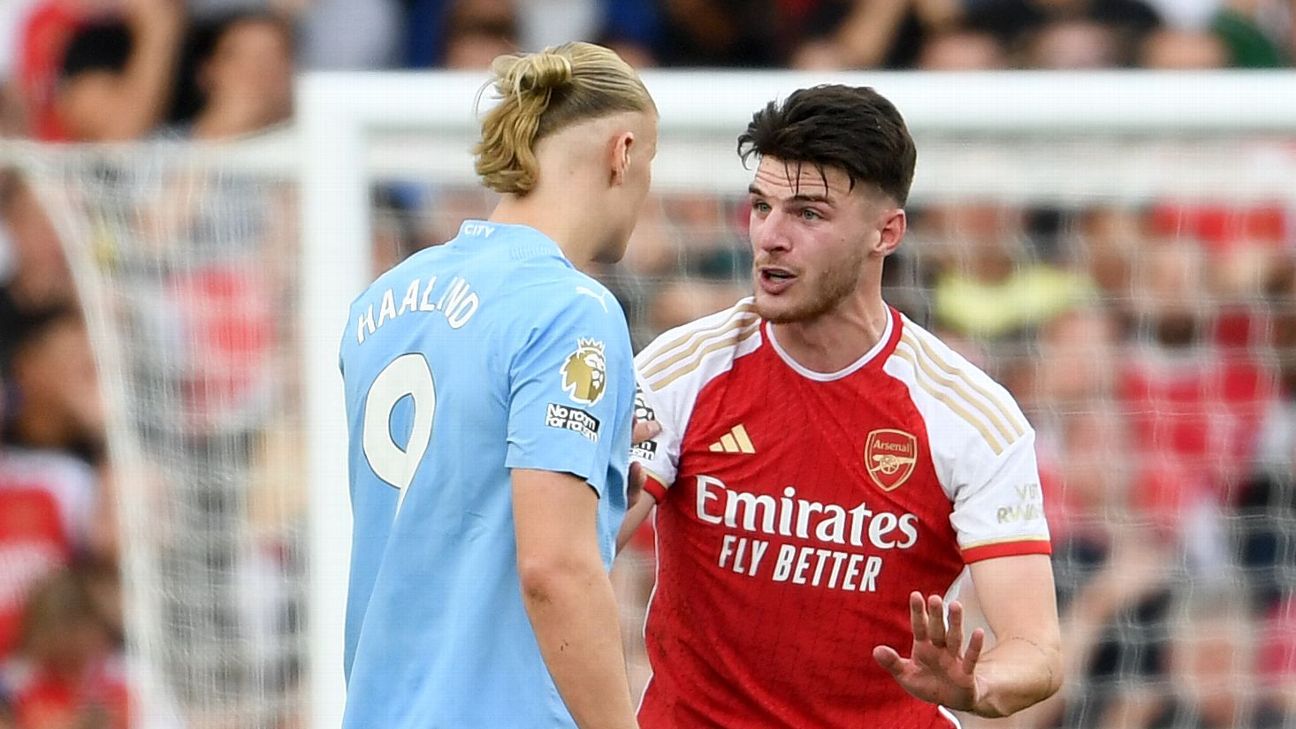This season is the same as every other season: It begins with Pep Guardiola’s Manchester City favored to win the league.
Even in 2016-17, his first season with the club — in a campaign that featured things like Claudio Bravo starting in goal, or Bacary Sagna and Gael Clichy pretending to be inverted full-backs, and ended with them finishing 15 points behind first-place Chelsea — Man City started it off as the bookmakers’ pick to win it all.
And the bookmakers have almost always been right. Outside of that first season and the 2019-20 season when Liverpool won the second-most points in league history, City have won the Premier League in six of Pep Guardiola’s eight seasons in charge. If anything, the bookmakers have undervalued City’s dominance.
Manchester City have won the league 75% of the time across the Guardiola era, but their preseason odds have never been proportionately high. If you’d bet City to win the league before each of the past eight seasons, you’d have made a significant profit.
Now, one of the ways that I’ve managed not to lose all of my money is that I’ve respected the betting markets as a source of knowledge, rather than something to be exploited. The market tells us what is most likely to happen in sports to a more accurate degree than any other source of publicly available information — if it didn’t and people could just easily beat the posted numbers, the sportsbooks would go out of business.
With that in mind, ESPN BET’s current odds give Manchester City a 47.6% chance (+110) of winning the Premier League this season. Take out the vig (the fee that books essentially charge you to place a bet), and the odds are even lower than that. So, with kickoff for the 2024-25 season just days away, Manchester City are still the individual favorites win it — but even if financial regulations don’t ruin City’s campaign, the field is favored over City.
Here’s why — and why Arsenal might be the real favorites by some measures this season.
1. Last season’s Man City were an average Guardiola team — not a great one
You can pick a stat, any stat. But let’s just start with the simplest ones: points and goal differential. The 91 points and plus-58 goal differential from last season were the fifth- and fourth-worst marks of the Guardiola era:

Now, it’s absurd to call this “average.” Across the 30-plus-year history of the Premier League, the champions have averaged about 87 points and a plus-50 goal differential. City were significantly better than the average Premier League champion last season, but they didn’t win four league titles in a row and six out of seven by simply being better than average, season after season.
As you can see from the chart, their points and goals numbers have been quite similar in each of the past two league seasons. If City, say, played at this exact level in the league for each of the past seven seasons, they’d have only four league titles, rather than the six they ended up with. To keep winning the league at the rate that City have, you have to churn out a couple of untouchable campaigns.
But if City score and concede goals at this exact level again next season, then they’re beatable.
2. The data says it’s likely Man City will regress in 2024-25
If we look at every City player to feature in at least 1,000 league minutes last season, there’s reason to expect some regression from more than half of them.
Rodri, the best player in the Premier League, led City in minutes last season, but he’s inching closer toward the end of his peak years and City still haven’t found a way to function at an elite level when he’s off the field.
Phil Foden, the Premier League player of the year, was second in City in minutes last season, but he outperformed his Expected Goals (xG) by a freakish 8.7 goals last season — by far the biggest divergence in the league. He’s probably a really good finisher, but no one is that good. Expect his goal total to drop off next season unless it’s paired with an even more abundant slate of high-quality attempts.
Éderson, City’s third most-used player, is open to a move to the Saudi league. Julián Álvarez, their fourth most-used player, has left for Atletico Madrid. Kyle Walker and Bernardo Silva, the fifth and sixth most-used players, respectively, will be 34 and 30 when the season starts. After that, the likes of Manuel Akanji (29), Nathan Aké (29), Mateo Kovacic (30), Kevin De Bruyne (33), and John Stones (30) will all be verging beyond or already past their peak years when the season starts.
If it’s just one or two key players sliding beyond their peak years, then it’s not much of a worry. Those players might not decline, and if they do, the players around them can pick up the slack and they can figure out a new way to shape their contribution so it still helps the team win just as much. But when you have this many players reaching toward or into their 30s, you create a situation where multiple key players could decline at the same time and the team could experience a sudden, seemingly unexpected drop-off in performance. See: Liverpool, 2022-23.
Manchester City’s roster, at the very least, seems more fragile than it’s been in a really long time.
Frank Leboeuf says that Liverpool have every chance of winning the Premier League under Arne Slot this season.
3. Instead of one team chasing close behind, Man City have two: Arsenal and Liverpool
If it were just Manchester City and Arsenal, City would be greater-than-50% favorites to win the league. If it were just City and Liverpool, City would be much-greater-than-50% favorites to win the league. But since it’s City and Arsenal and Liverpool, the majority of the championship equity sits with the field, rather than the four-time defending champs.
In their first five league wins under Guardiola, City were 19.6 points ahead of the third-place team, on average. Last season, Liverpool finished nine points behind City — and 14 points ahead of Aston Villa. The gap between first and third was smaller than the gap between third and fourth.
4. Man City weren’t even necessarily the best team in the league last season, despite winning it
I’ve used this image a couple of times recently, but it bears reuse once more.
While xG is the most predictive single stat for future team performance, analysis from Ben Torvaney (once of AC Milan and now working for Liverpool’s former head of research, Ian Graham) showed that a blend of xG and goals was even more predictive. Torvaney found that 70% xG and 30% goals held the most information for how teams would perform in the future.
Based on that, here’s how everyone stacks up via an adjusted per-game goal differential that’s 70% of what a team’s xG differential was and 30% of what a team’s goal differential was last season:

You’ll see Arsenal on top, and that’s the first time in the Guardiola era, including that transitional first season, that City haven’t led the league in this powerful metric. When Liverpool won the league, they still trailed well behind City in adjusted goal differential. And in the two seasons they chased them to the final day with 90-plus points and runs to the Champions League final, their numbers were absurd — but still not as good as City’s.
In other words: If you were predicting this season based purely on last season’s underlying performance, Arsenal would be the slight favorites to win it all.
5. Arsenal (and Liverpool) might get even better, too
The biggest warning sign for Arsenal is health. Meaning: the Gunners had a ton of it last season. Their best players were almost always on the field:
• William Saliba: played 100% of Premier League minutes
• Declan Rice: 94.3%
• Martin Ødegaard: 90.4%
• Gabriel: 89%
• Ben White: 87.4%
• Bukayo Saka: 85.4%
Those are the six guys you’d say have no real replacement on the rest of the roster, and Arsenal manager Mikel Arteta didn’t have to spend any time trying to figure out how to do it. City, meanwhile, lost De Bruyne on the opening day, and he ended up playing fewer than 50% of the available minutes. While Liverpool lost pretty much everyone on the roster other than Virgil van Dijk for significant periods of time.
If you wanted to short Arsenal, this is why you’d do it — not because there’s some kind of teamwide psychological block that prevents them from getting over the hump. At the same time, the biggest predictor of future injury is past injury, and perhaps these are all the kinds of players who can be relied on for large minutes loads, year in and year out.
But while that’s all a little murky in terms of deciding what it might mean for this season, here’s something that isn’t: the age of Arsenal’s squad.
Weighted by minutes played, the average age of Arsenal’s players last season was 25.0 — the third-lowest number in the league. What that means is that there’s almost no-one on the Arsenal roster who we should expect to decline because of their age, outside of 32-year-old Jorginho and 30-year-old Leandro Trossard. The former only played some 900 minutes in the league last season, while the latter did score 12 goals but was still mainly used off the bench.
Instead, Arsenal have many core players in the middle of their prime years (24 to 28). Rice, Ødegaard, Gabriel and White are all directly in the middle of this range, as is Kai Havertz. Meanwhile, Oleksandr Zinchenko and Gabriel Jesus are toward the back but still within the prime-age range. David Raya turns 29 in a few months, but goalkeepers tend to age later, so he’s right in his prime as well. These players are all at the ages when professional soccer players tend to be at their best.
But then Arsenal have a number of star players who we should expect to get even better. Saka won’t be 23 until September, Saliba turns 24 in March, and Gabriel Martinelli will be 23 for the entire season.
Saka has improved with each passing season. His non-penalty xG plus expected goals assisted numbers over the past four seasons:
• 2020-21: 0.40 per 90 minutes
• 2021-22: 0.49
• 2022-23: 0.50
• 2023-24: 0.65
The final stage in Saka’s development would be for him to become a truly elite goal scorer and shot creator. Would it shock anyone if this was the season that finally happened?
Saliba is already one of the best center-backs in the word. The one clear area of development would be for him to get better in the air: he doesn’t contest many headers, but he still wins headers at a relatively meager rate. You’ve seen the guy — he’s a unit. There’s no real reason he can’t be dominant in the air. This, too, could be the season that happens.
But perhaps the biggest area for individual improvement — and the one I’m most willing to actively predict — comes with Martinelli. Two years ago, he was just as good of a prospect as Saka, if not better. And in the season before last, he scored 15 non-penalty goals and added five assists.
In 2023-24, though, he scored only six and assisted on four. Just a couple more goals or assists from Martinelli last season, and Arsenal are coming into this season as defending champs. It was the worst season of Martinelli’s career — at the worst possible time. But most of the decline comes down to the ball not going into the net, from his shots and the shots he created for everyone else.

Despite the lack of production, Martinelli’s underlying performance was almost the exact same as the season before: 0.59 xG+xA in 22-23 and 0.58 last season. And so, Martinelli fits the profile for the kind of player who could have an explosive bounceback season. We should expect his goals and assists to more closely align with his underlying numbers this season and he’s at an age where those underlying numbers could significantly improve.
Liverpool, too, have a number of players who could break out this season: Darwin Núñez, Dominik Szoboszlai, Harvey Elliott, Conor Bradley and Ryan Gravenberch among them. Plus, it’s hard to see them being as injured as they were last season. Fewer injuries, plus Darwin and Szoboszlai becoming true stars, equals a title-quality team even without Jurgen Klopp as manager.
In addition to the external improvement, Arsenal should have 23-year-old Jurriën Timber, who missed almost all of last season due to injury, healthy for the season opener, and they’ve added 22-year-old Riccardo Calafiori from Bologna in the transfer window. Two young, flexible, defensive options give them a better chance of solving last season’s biggest problem position: left-back. They also seem to be trying to add another midfielder, and that would prevent a reliance on aging Jorginho or an out-of-position Havertz.
Liverpool haven’t signed anyone yet, but there’s really only one hole in their starting lineup: defensive midfield. According to reports, they tried and failed to sign 25-year-old Real Sociedad midfielder Martín Zubimendi for the role. There’s no guarantee Zubimendi would have succeeded — or that another target will succeed — but acquiring a player in this position represents another immediate path to improvement for the side under new manager Arne Slot.
Manchester City, of course, have more resources than either Arsenal or Liverpool, but so far they’ve brought in Sávio from Girona and lost Julián Álvarez to Atletico Madrid — a player exchange that’s at best a net neutral for the roster.
Given Man City’s coach and track record of success, as well the existence of Erling Haaland, this could all look silly come May. Picking anyone else has looked silly come May in all but one of the past seven seasons. And City do still deserve to be favorites. But their edges have eroded enough and their rivals both have enough paths to improvement. So, given a choice between Manchester City or Arsenal and Liverpool, I’m taking the other two.



